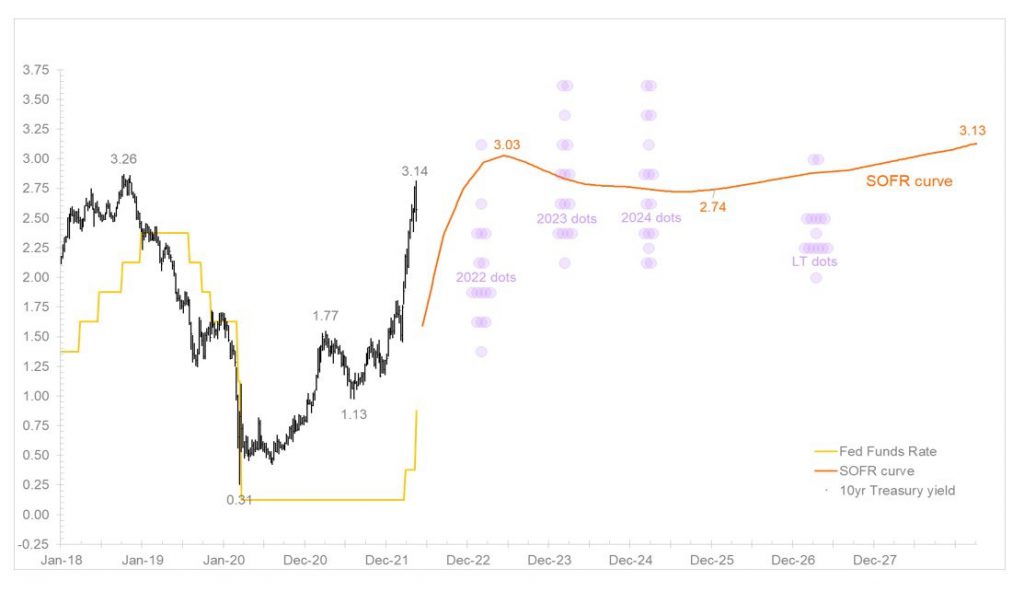SOFR curve analytics & research
MacroVar analyses the SOFR forward curve to monitor the market's expectations for the Federal reserve's future monetary policy actions (rate hikes/cuts) depending on the current dynamics of financial markets and macroeconomic indicators. Explore how to interpret the SOFR forward curve dynamics.SOFR curve
MacroVar presents the current shape of the SOFR curve (Last) compared to the SOFR curve in previous periods (1 week ago, 1month). The shape of the SOFR curve which is assembled from SOFR futures provides estimates of the assumed path for the specific reference periods.What is the SOFR curve
The SOFR (Secured Overnight Financing Rate) forward curve is a representation of expected future SOFR rates at various points in time. SOFR is a benchmark interest rate that serves as a replacement for the traditional LIBOR (London Interbank Offered Rate) in the United States. It is based on actual transactions in the overnight U.S. Treasury repurchase agreement (repo) market and is considered a more robust and reliable reference rate.
The SOFR forward curve is used by financial institutions, investors, and market participants to estimate and project future borrowing and lending costs, as well as to value various financial instruments and derivatives. It is important for risk management, interest rate hedging, and pricing various financial products.
SOFR forward curves can be constructed using a combination of historical SOFR rates and market-based expectations for future SOFR rates. These curves are typically derived from various sources, including trading in SOFR-linked derivatives, such as futures and swaps, as well as market surveys and expert judgment.
The construction of SOFR forward curves is essential for the transition away from LIBOR, as it provides a reference point for pricing and valuing financial products tied to SOFR. The curves typically cover various tenors (e.g., 1-month, 3-month, 6-month), allowing market participants to have a view of the future interest rate landscape based on SOFR.
It's worth noting that the development and usage of SOFR forward curves may evolve over time as the financial industry continues to adapt to the post-LIBOR environment, and regulatory guidance may also play a role in shaping how these curves are determined and used.
Interpreting the SOFR Forward Curve dynamics
When the US economy is strong and inflation expectations are rising the market is expecting central banks to raise rates in order to decelerate economic and inflation expectations. Short-term interest rates like the SOFR 3-month and 1-month interest rate are linked to the macroeconomic environment, fiscal and monetary policies and the financial markets (commodities).Hence, short term interest rates should be expected to rise and their related futures which are the 3-month SOFR futures should sell off (note: implied interest rate for futures is calculated as 100 minus the futures price). At the same time and since markets are interrelated, fixed income markets are linked the Yield Curve (10-year minus 3-month). The Yield curve steepens when growth expectations are rising and flattens when growth falls (MacroVar monitors all macroeconomic and financial factors which are leading indicators of growth expectations).
When central banks set rates correctly, we should expect smooth slope implied curve in the short term interest rate futures markets.
Highly sloping implied rate curves imply that the central bank reacted too late, the economy has overheated causing inflationary pressures and the futures markets imply aggressive interest rate hikes.
An Inverted implied rate curve implies that the central bank reacted too late, hence has to be more aggressive in order to combat inflation pressures, causing the business cycle to shorten, a possible recession due to early fast hikes and interest rate cuts later on to combat an impeding recession.
The Federal reserves's FOMC meetings affect these markets to a large extent. When the FED becomes more hawkish (tendency to raise rates) or dovish by either adjusting interest rates and/or use QE/QT, it affects the Short-term interest rates futures markets directly.
When the US 2-year bond yield which is determined by market forces falls below the FED refinancing rate it implies the market expects FED to cut interest rates in the short-term future in order to boost the economy which is currently weak.